Managing Innovation Report: Made.com and Blue Ocean Theory
VerifiedAdded on 2022/12/30
|11
|3621
|82
Report
AI Summary
This report provides a comprehensive analysis of Made.com's innovation strategies, focusing on the application of the Blue Ocean Theory. The report begins with an introduction to innovation and the chosen theory, followed by a detailed description of the Blue Ocean Theory, including its principles, processes, and evaluation of its benefits and limitations. The main body of the report then applies the theory to explain the historical development of Made.com, a leading online furniture retailer, examining its business model and the evolution of its products and services. The report further extends its analysis by recommending possible future development pathways for Made.com based on the principles of the Blue Ocean Theory. The structure includes an introduction, a detailed theoretical explanation, an application of the theory in the historical context of the company, and a final section recommending future development pathways. The report references relevant academic sources and provides a critical analysis of the subject matter.
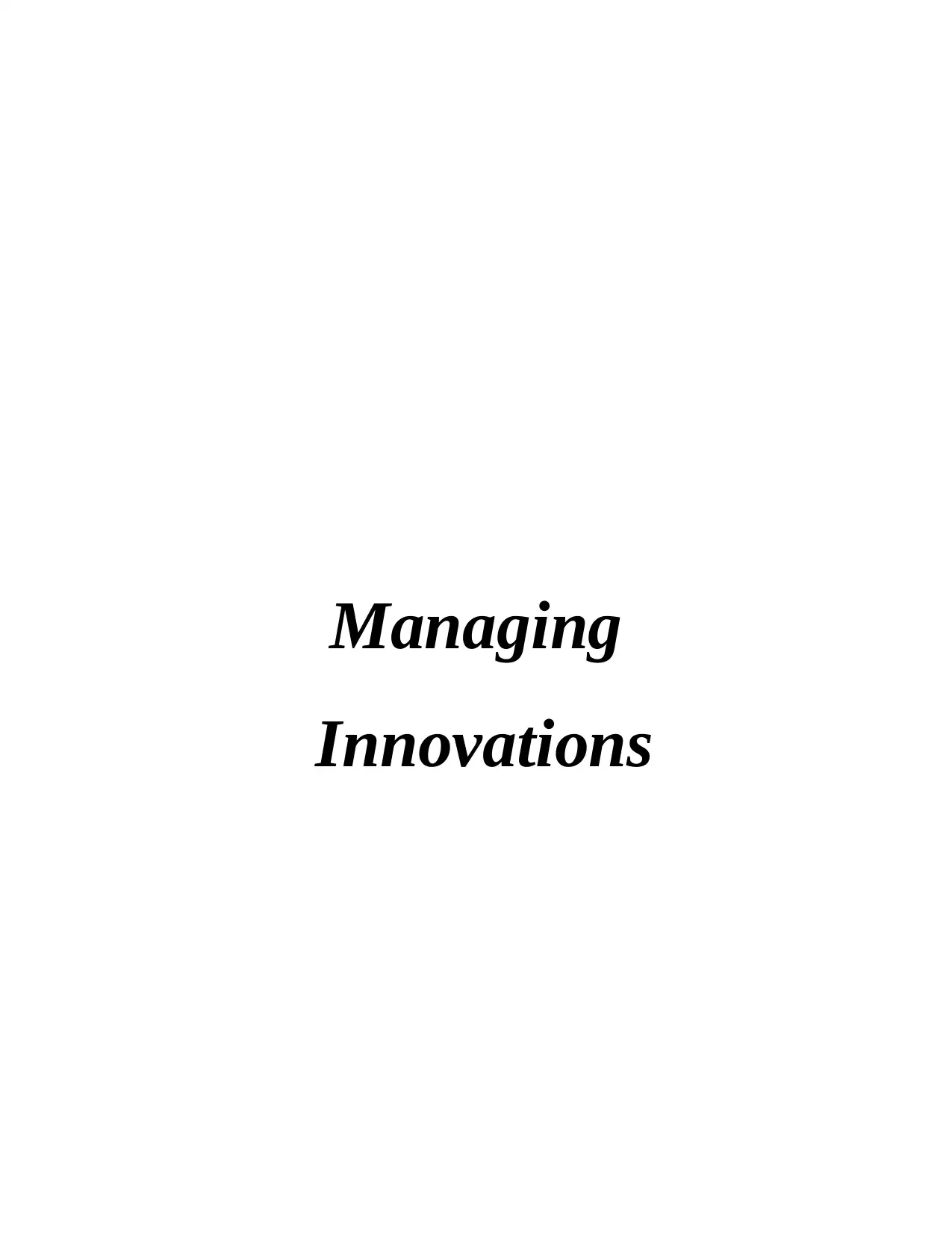
Managing
Innovations
Innovations
Paraphrase This Document
Need a fresh take? Get an instant paraphrase of this document with our AI Paraphraser
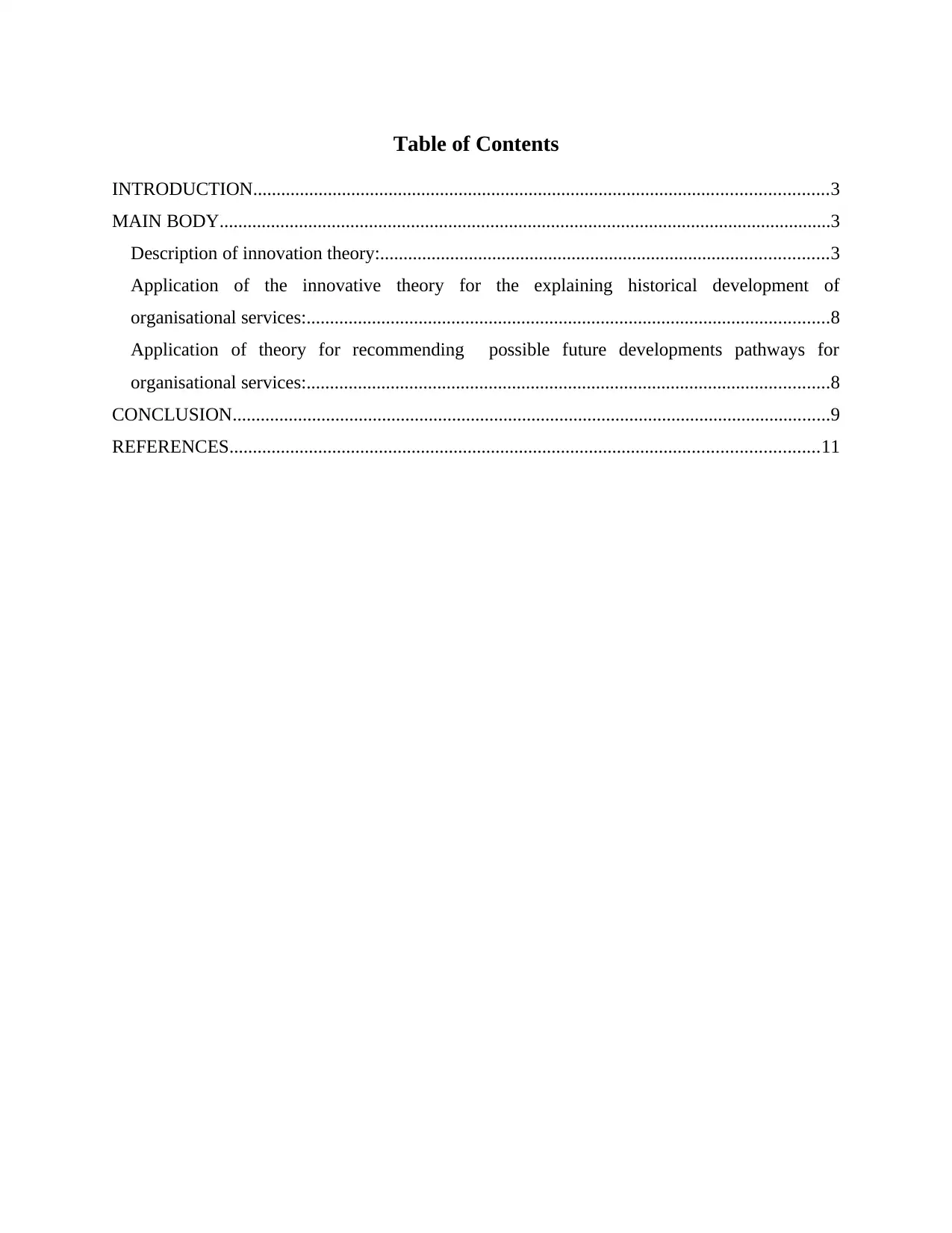
Table of Contents
INTRODUCTION...........................................................................................................................3
MAIN BODY...................................................................................................................................3
Description of innovation theory:................................................................................................3
Application of the innovative theory for the explaining historical development of
organisational services:................................................................................................................8
Application of theory for recommending possible future developments pathways for
organisational services:................................................................................................................8
CONCLUSION................................................................................................................................9
REFERENCES..............................................................................................................................11
INTRODUCTION...........................................................................................................................3
MAIN BODY...................................................................................................................................3
Description of innovation theory:................................................................................................3
Application of the innovative theory for the explaining historical development of
organisational services:................................................................................................................8
Application of theory for recommending possible future developments pathways for
organisational services:................................................................................................................8
CONCLUSION................................................................................................................................9
REFERENCES..............................................................................................................................11
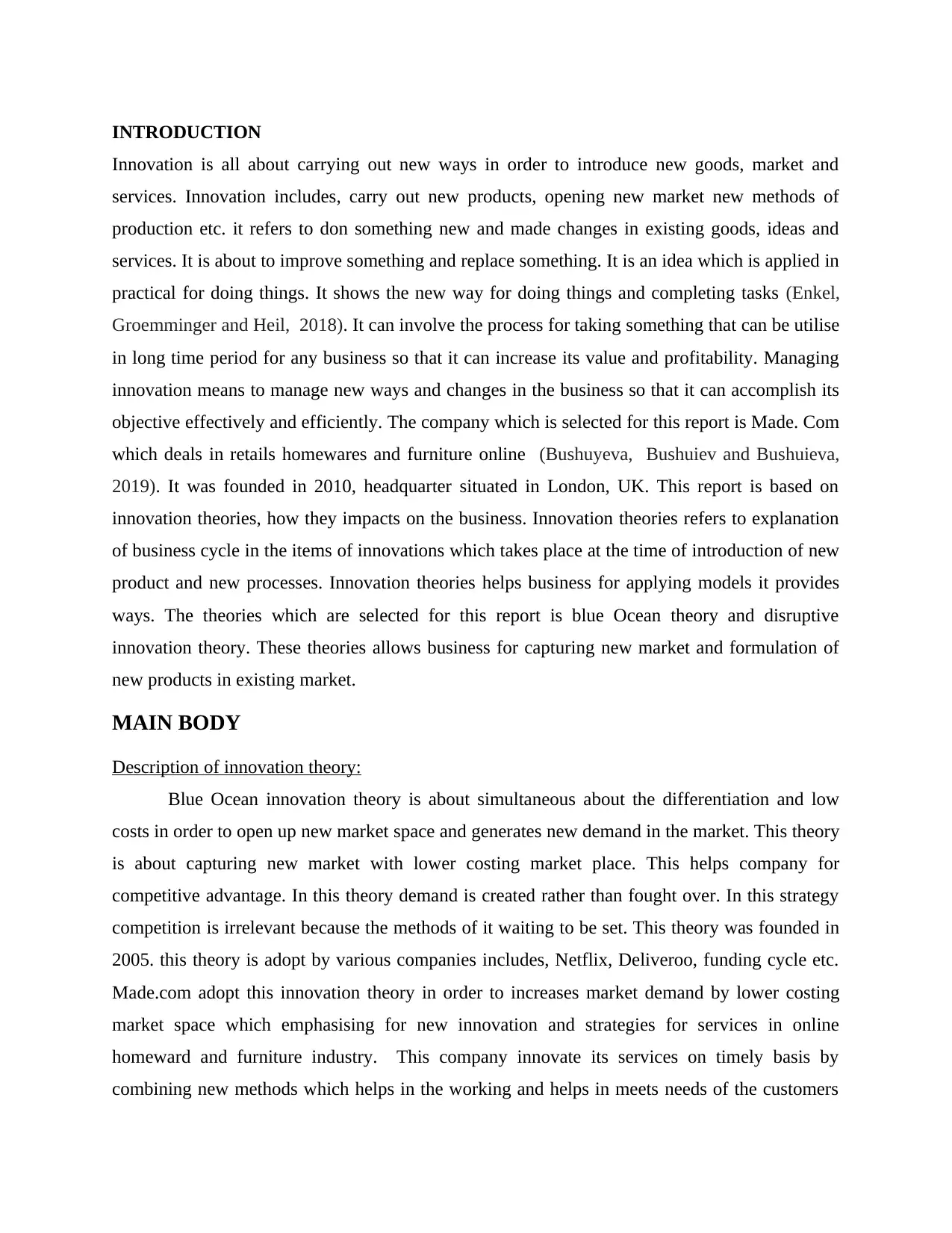
INTRODUCTION
Innovation is all about carrying out new ways in order to introduce new goods, market and
services. Innovation includes, carry out new products, opening new market new methods of
production etc. it refers to don something new and made changes in existing goods, ideas and
services. It is about to improve something and replace something. It is an idea which is applied in
practical for doing things. It shows the new way for doing things and completing tasks (Enkel,
Groemminger and Heil, 2018). It can involve the process for taking something that can be utilise
in long time period for any business so that it can increase its value and profitability. Managing
innovation means to manage new ways and changes in the business so that it can accomplish its
objective effectively and efficiently. The company which is selected for this report is Made. Com
which deals in retails homewares and furniture online (Bushuyeva, Bushuiev and Bushuieva,
2019). It was founded in 2010, headquarter situated in London, UK. This report is based on
innovation theories, how they impacts on the business. Innovation theories refers to explanation
of business cycle in the items of innovations which takes place at the time of introduction of new
product and new processes. Innovation theories helps business for applying models it provides
ways. The theories which are selected for this report is blue Ocean theory and disruptive
innovation theory. These theories allows business for capturing new market and formulation of
new products in existing market.
MAIN BODY
Description of innovation theory:
Blue Ocean innovation theory is about simultaneous about the differentiation and low
costs in order to open up new market space and generates new demand in the market. This theory
is about capturing new market with lower costing market place. This helps company for
competitive advantage. In this theory demand is created rather than fought over. In this strategy
competition is irrelevant because the methods of it waiting to be set. This theory was founded in
2005. this theory is adopt by various companies includes, Netflix, Deliveroo, funding cycle etc.
Made.com adopt this innovation theory in order to increases market demand by lower costing
market space which emphasising for new innovation and strategies for services in online
homeward and furniture industry. This company innovate its services on timely basis by
combining new methods which helps in the working and helps in meets needs of the customers
Innovation is all about carrying out new ways in order to introduce new goods, market and
services. Innovation includes, carry out new products, opening new market new methods of
production etc. it refers to don something new and made changes in existing goods, ideas and
services. It is about to improve something and replace something. It is an idea which is applied in
practical for doing things. It shows the new way for doing things and completing tasks (Enkel,
Groemminger and Heil, 2018). It can involve the process for taking something that can be utilise
in long time period for any business so that it can increase its value and profitability. Managing
innovation means to manage new ways and changes in the business so that it can accomplish its
objective effectively and efficiently. The company which is selected for this report is Made. Com
which deals in retails homewares and furniture online (Bushuyeva, Bushuiev and Bushuieva,
2019). It was founded in 2010, headquarter situated in London, UK. This report is based on
innovation theories, how they impacts on the business. Innovation theories refers to explanation
of business cycle in the items of innovations which takes place at the time of introduction of new
product and new processes. Innovation theories helps business for applying models it provides
ways. The theories which are selected for this report is blue Ocean theory and disruptive
innovation theory. These theories allows business for capturing new market and formulation of
new products in existing market.
MAIN BODY
Description of innovation theory:
Blue Ocean innovation theory is about simultaneous about the differentiation and low
costs in order to open up new market space and generates new demand in the market. This theory
is about capturing new market with lower costing market place. This helps company for
competitive advantage. In this theory demand is created rather than fought over. In this strategy
competition is irrelevant because the methods of it waiting to be set. This theory was founded in
2005. this theory is adopt by various companies includes, Netflix, Deliveroo, funding cycle etc.
Made.com adopt this innovation theory in order to increases market demand by lower costing
market space which emphasising for new innovation and strategies for services in online
homeward and furniture industry. This company innovate its services on timely basis by
combining new methods which helps in the working and helps in meets needs of the customers
⊘ This is a preview!⊘
Do you want full access?
Subscribe today to unlock all pages.

Trusted by 1+ million students worldwide
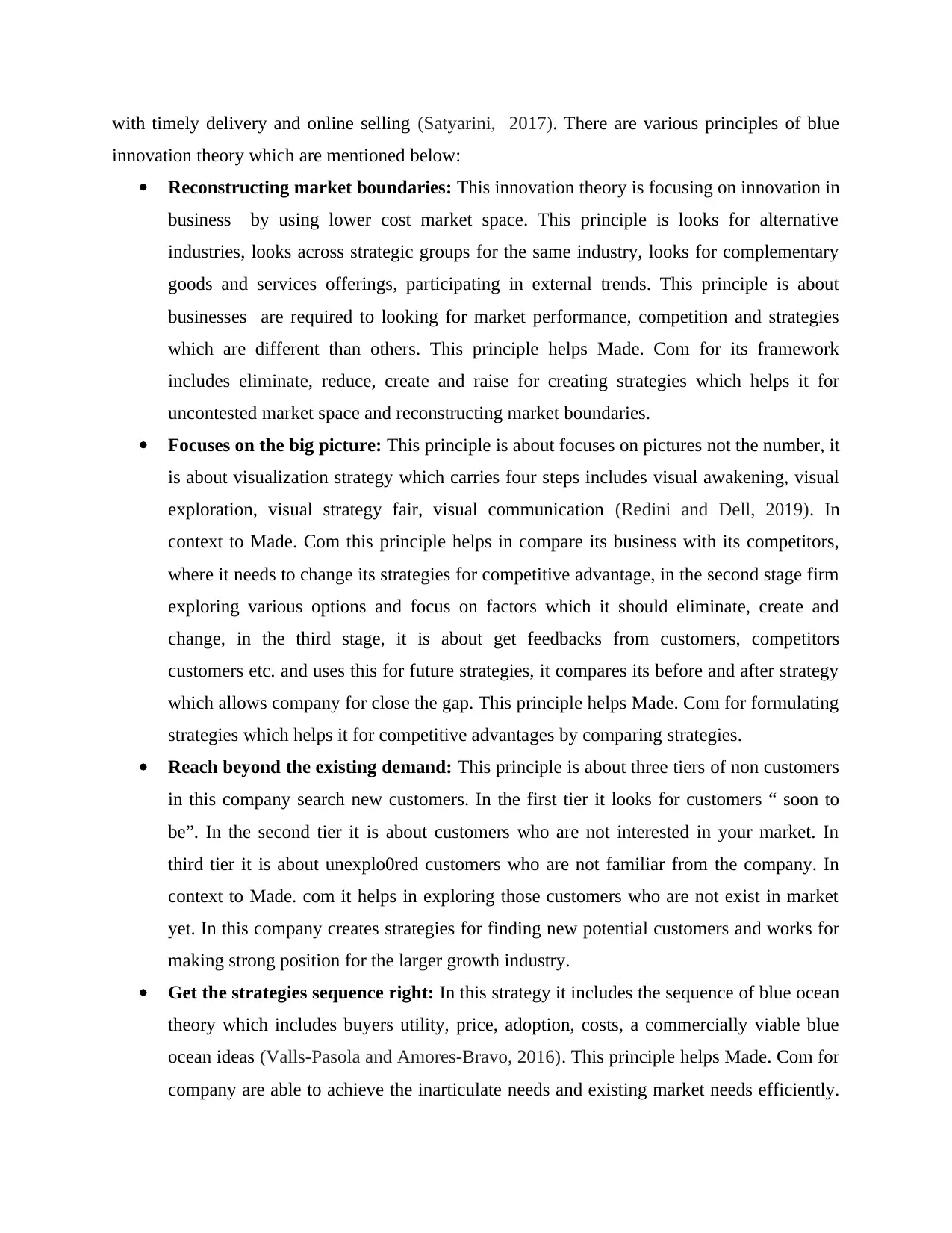
with timely delivery and online selling (Satyarini, 2017). There are various principles of blue
innovation theory which are mentioned below:
Reconstructing market boundaries: This innovation theory is focusing on innovation in
business by using lower cost market space. This principle is looks for alternative
industries, looks across strategic groups for the same industry, looks for complementary
goods and services offerings, participating in external trends. This principle is about
businesses are required to looking for market performance, competition and strategies
which are different than others. This principle helps Made. Com for its framework
includes eliminate, reduce, create and raise for creating strategies which helps it for
uncontested market space and reconstructing market boundaries.
Focuses on the big picture: This principle is about focuses on pictures not the number, it
is about visualization strategy which carries four steps includes visual awakening, visual
exploration, visual strategy fair, visual communication (Redini and Dell, 2019). In
context to Made. Com this principle helps in compare its business with its competitors,
where it needs to change its strategies for competitive advantage, in the second stage firm
exploring various options and focus on factors which it should eliminate, create and
change, in the third stage, it is about get feedbacks from customers, competitors
customers etc. and uses this for future strategies, it compares its before and after strategy
which allows company for close the gap. This principle helps Made. Com for formulating
strategies which helps it for competitive advantages by comparing strategies.
Reach beyond the existing demand: This principle is about three tiers of non customers
in this company search new customers. In the first tier it looks for customers “ soon to
be”. In the second tier it is about customers who are not interested in your market. In
third tier it is about unexplo0red customers who are not familiar from the company. In
context to Made. com it helps in exploring those customers who are not exist in market
yet. In this company creates strategies for finding new potential customers and works for
making strong position for the larger growth industry.
Get the strategies sequence right: In this strategy it includes the sequence of blue ocean
theory which includes buyers utility, price, adoption, costs, a commercially viable blue
ocean ideas (Valls-Pasola and Amores-Bravo, 2016). This principle helps Made. Com for
company are able to achieve the inarticulate needs and existing market needs efficiently.
innovation theory which are mentioned below:
Reconstructing market boundaries: This innovation theory is focusing on innovation in
business by using lower cost market space. This principle is looks for alternative
industries, looks across strategic groups for the same industry, looks for complementary
goods and services offerings, participating in external trends. This principle is about
businesses are required to looking for market performance, competition and strategies
which are different than others. This principle helps Made. Com for its framework
includes eliminate, reduce, create and raise for creating strategies which helps it for
uncontested market space and reconstructing market boundaries.
Focuses on the big picture: This principle is about focuses on pictures not the number, it
is about visualization strategy which carries four steps includes visual awakening, visual
exploration, visual strategy fair, visual communication (Redini and Dell, 2019). In
context to Made. Com this principle helps in compare its business with its competitors,
where it needs to change its strategies for competitive advantage, in the second stage firm
exploring various options and focus on factors which it should eliminate, create and
change, in the third stage, it is about get feedbacks from customers, competitors
customers etc. and uses this for future strategies, it compares its before and after strategy
which allows company for close the gap. This principle helps Made. Com for formulating
strategies which helps it for competitive advantages by comparing strategies.
Reach beyond the existing demand: This principle is about three tiers of non customers
in this company search new customers. In the first tier it looks for customers “ soon to
be”. In the second tier it is about customers who are not interested in your market. In
third tier it is about unexplo0red customers who are not familiar from the company. In
context to Made. com it helps in exploring those customers who are not exist in market
yet. In this company creates strategies for finding new potential customers and works for
making strong position for the larger growth industry.
Get the strategies sequence right: In this strategy it includes the sequence of blue ocean
theory which includes buyers utility, price, adoption, costs, a commercially viable blue
ocean ideas (Valls-Pasola and Amores-Bravo, 2016). This principle helps Made. Com for
company are able to achieve the inarticulate needs and existing market needs efficiently.
Paraphrase This Document
Need a fresh take? Get an instant paraphrase of this document with our AI Paraphraser
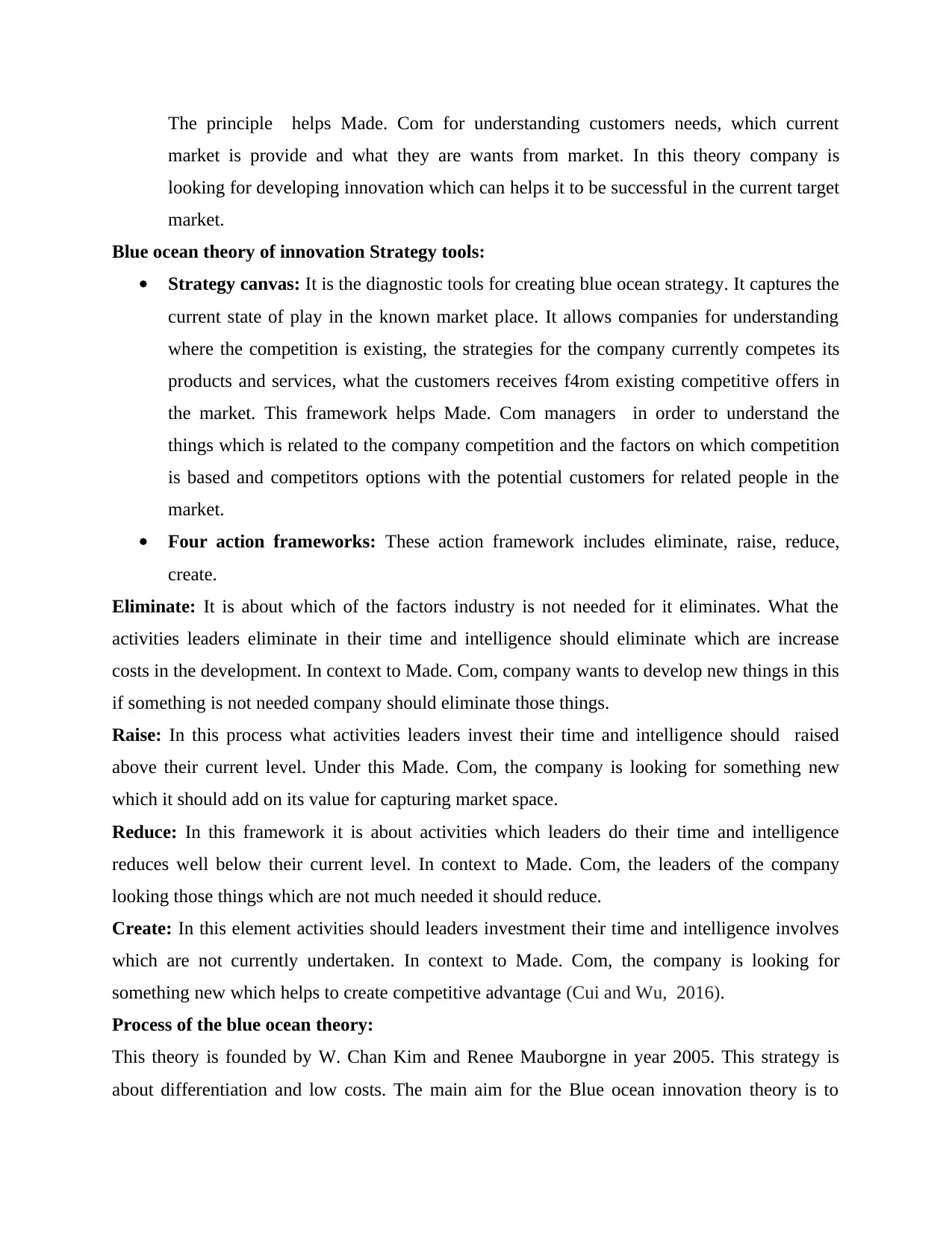
The principle helps Made. Com for understanding customers needs, which current
market is provide and what they are wants from market. In this theory company is
looking for developing innovation which can helps it to be successful in the current target
market.
Blue ocean theory of innovation Strategy tools:
Strategy canvas: It is the diagnostic tools for creating blue ocean strategy. It captures the
current state of play in the known market place. It allows companies for understanding
where the competition is existing, the strategies for the company currently competes its
products and services, what the customers receives f4rom existing competitive offers in
the market. This framework helps Made. Com managers in order to understand the
things which is related to the company competition and the factors on which competition
is based and competitors options with the potential customers for related people in the
market.
Four action frameworks: These action framework includes eliminate, raise, reduce,
create.
Eliminate: It is about which of the factors industry is not needed for it eliminates. What the
activities leaders eliminate in their time and intelligence should eliminate which are increase
costs in the development. In context to Made. Com, company wants to develop new things in this
if something is not needed company should eliminate those things.
Raise: In this process what activities leaders invest their time and intelligence should raised
above their current level. Under this Made. Com, the company is looking for something new
which it should add on its value for capturing market space.
Reduce: In this framework it is about activities which leaders do their time and intelligence
reduces well below their current level. In context to Made. Com, the leaders of the company
looking those things which are not much needed it should reduce.
Create: In this element activities should leaders investment their time and intelligence involves
which are not currently undertaken. In context to Made. Com, the company is looking for
something new which helps to create competitive advantage (Cui and Wu, 2016).
Process of the blue ocean theory:
This theory is founded by W. Chan Kim and Renee Mauborgne in year 2005. This strategy is
about differentiation and low costs. The main aim for the Blue ocean innovation theory is to
market is provide and what they are wants from market. In this theory company is
looking for developing innovation which can helps it to be successful in the current target
market.
Blue ocean theory of innovation Strategy tools:
Strategy canvas: It is the diagnostic tools for creating blue ocean strategy. It captures the
current state of play in the known market place. It allows companies for understanding
where the competition is existing, the strategies for the company currently competes its
products and services, what the customers receives f4rom existing competitive offers in
the market. This framework helps Made. Com managers in order to understand the
things which is related to the company competition and the factors on which competition
is based and competitors options with the potential customers for related people in the
market.
Four action frameworks: These action framework includes eliminate, raise, reduce,
create.
Eliminate: It is about which of the factors industry is not needed for it eliminates. What the
activities leaders eliminate in their time and intelligence should eliminate which are increase
costs in the development. In context to Made. Com, company wants to develop new things in this
if something is not needed company should eliminate those things.
Raise: In this process what activities leaders invest their time and intelligence should raised
above their current level. Under this Made. Com, the company is looking for something new
which it should add on its value for capturing market space.
Reduce: In this framework it is about activities which leaders do their time and intelligence
reduces well below their current level. In context to Made. Com, the leaders of the company
looking those things which are not much needed it should reduce.
Create: In this element activities should leaders investment their time and intelligence involves
which are not currently undertaken. In context to Made. Com, the company is looking for
something new which helps to create competitive advantage (Cui and Wu, 2016).
Process of the blue ocean theory:
This theory is founded by W. Chan Kim and Renee Mauborgne in year 2005. This strategy is
about differentiation and low costs. The main aim for the Blue ocean innovation theory is to
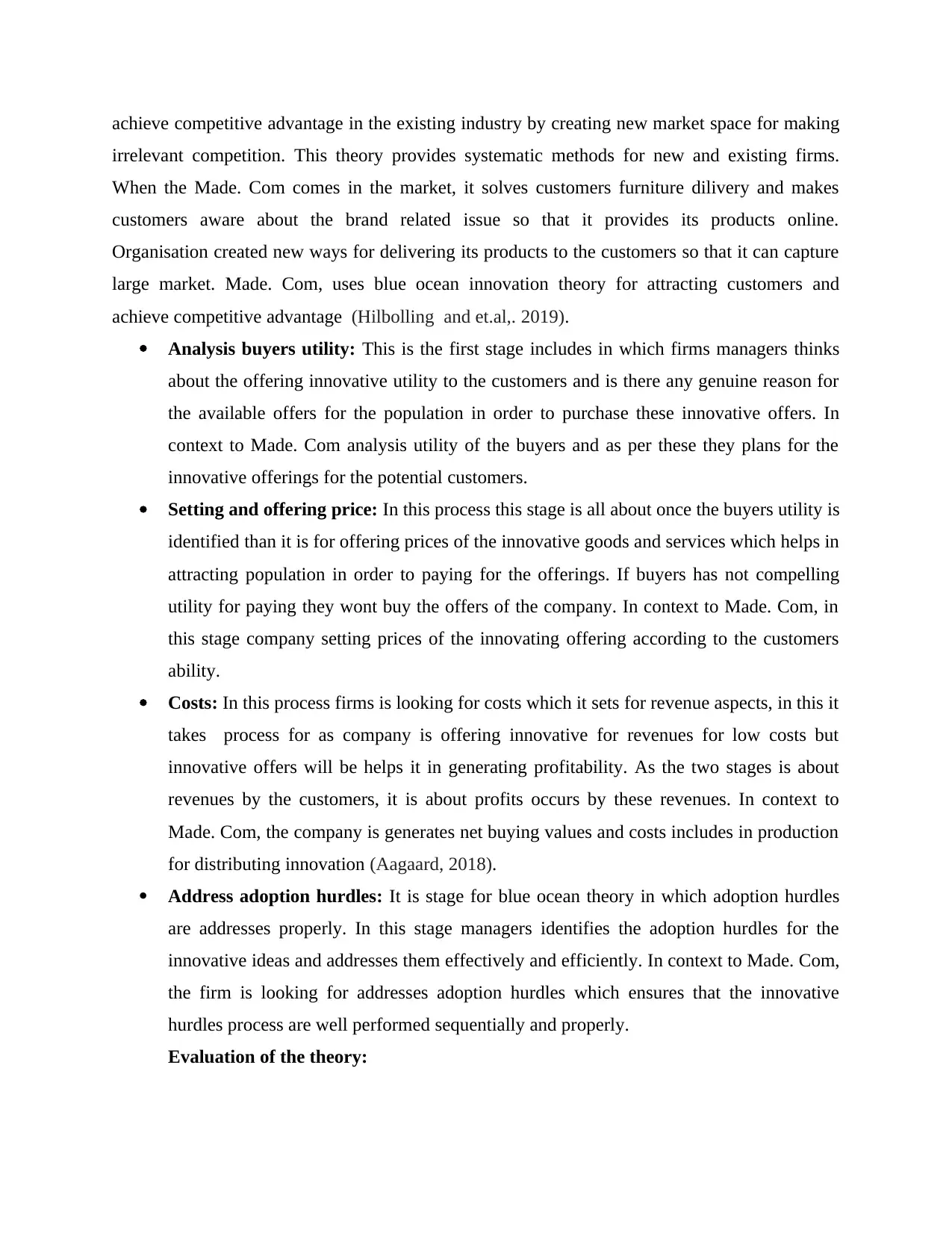
achieve competitive advantage in the existing industry by creating new market space for making
irrelevant competition. This theory provides systematic methods for new and existing firms.
When the Made. Com comes in the market, it solves customers furniture dilivery and makes
customers aware about the brand related issue so that it provides its products online.
Organisation created new ways for delivering its products to the customers so that it can capture
large market. Made. Com, uses blue ocean innovation theory for attracting customers and
achieve competitive advantage (Hilbolling and et.al,. 2019).
Analysis buyers utility: This is the first stage includes in which firms managers thinks
about the offering innovative utility to the customers and is there any genuine reason for
the available offers for the population in order to purchase these innovative offers. In
context to Made. Com analysis utility of the buyers and as per these they plans for the
innovative offerings for the potential customers.
Setting and offering price: In this process this stage is all about once the buyers utility is
identified than it is for offering prices of the innovative goods and services which helps in
attracting population in order to paying for the offerings. If buyers has not compelling
utility for paying they wont buy the offers of the company. In context to Made. Com, in
this stage company setting prices of the innovating offering according to the customers
ability.
Costs: In this process firms is looking for costs which it sets for revenue aspects, in this it
takes process for as company is offering innovative for revenues for low costs but
innovative offers will be helps it in generating profitability. As the two stages is about
revenues by the customers, it is about profits occurs by these revenues. In context to
Made. Com, the company is generates net buying values and costs includes in production
for distributing innovation (Aagaard, 2018).
Address adoption hurdles: It is stage for blue ocean theory in which adoption hurdles
are addresses properly. In this stage managers identifies the adoption hurdles for the
innovative ideas and addresses them effectively and efficiently. In context to Made. Com,
the firm is looking for addresses adoption hurdles which ensures that the innovative
hurdles process are well performed sequentially and properly.
Evaluation of the theory:
irrelevant competition. This theory provides systematic methods for new and existing firms.
When the Made. Com comes in the market, it solves customers furniture dilivery and makes
customers aware about the brand related issue so that it provides its products online.
Organisation created new ways for delivering its products to the customers so that it can capture
large market. Made. Com, uses blue ocean innovation theory for attracting customers and
achieve competitive advantage (Hilbolling and et.al,. 2019).
Analysis buyers utility: This is the first stage includes in which firms managers thinks
about the offering innovative utility to the customers and is there any genuine reason for
the available offers for the population in order to purchase these innovative offers. In
context to Made. Com analysis utility of the buyers and as per these they plans for the
innovative offerings for the potential customers.
Setting and offering price: In this process this stage is all about once the buyers utility is
identified than it is for offering prices of the innovative goods and services which helps in
attracting population in order to paying for the offerings. If buyers has not compelling
utility for paying they wont buy the offers of the company. In context to Made. Com, in
this stage company setting prices of the innovating offering according to the customers
ability.
Costs: In this process firms is looking for costs which it sets for revenue aspects, in this it
takes process for as company is offering innovative for revenues for low costs but
innovative offers will be helps it in generating profitability. As the two stages is about
revenues by the customers, it is about profits occurs by these revenues. In context to
Made. Com, the company is generates net buying values and costs includes in production
for distributing innovation (Aagaard, 2018).
Address adoption hurdles: It is stage for blue ocean theory in which adoption hurdles
are addresses properly. In this stage managers identifies the adoption hurdles for the
innovative ideas and addresses them effectively and efficiently. In context to Made. Com,
the firm is looking for addresses adoption hurdles which ensures that the innovative
hurdles process are well performed sequentially and properly.
Evaluation of the theory:
⊘ This is a preview!⊘
Do you want full access?
Subscribe today to unlock all pages.

Trusted by 1+ million students worldwide
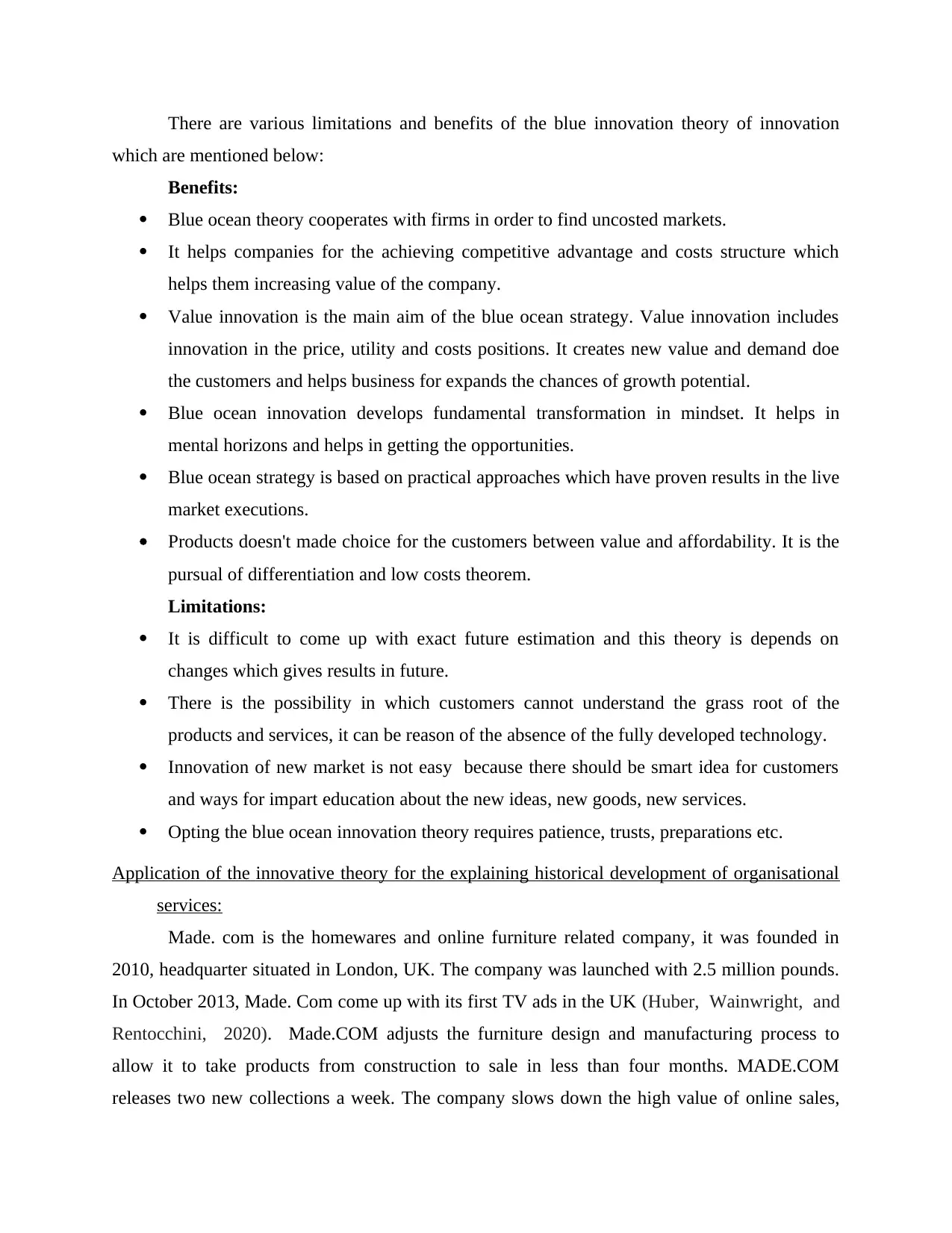
There are various limitations and benefits of the blue innovation theory of innovation
which are mentioned below:
Benefits:
Blue ocean theory cooperates with firms in order to find uncosted markets.
It helps companies for the achieving competitive advantage and costs structure which
helps them increasing value of the company.
Value innovation is the main aim of the blue ocean strategy. Value innovation includes
innovation in the price, utility and costs positions. It creates new value and demand doe
the customers and helps business for expands the chances of growth potential.
Blue ocean innovation develops fundamental transformation in mindset. It helps in
mental horizons and helps in getting the opportunities.
Blue ocean strategy is based on practical approaches which have proven results in the live
market executions.
Products doesn't made choice for the customers between value and affordability. It is the
pursual of differentiation and low costs theorem.
Limitations:
It is difficult to come up with exact future estimation and this theory is depends on
changes which gives results in future.
There is the possibility in which customers cannot understand the grass root of the
products and services, it can be reason of the absence of the fully developed technology.
Innovation of new market is not easy because there should be smart idea for customers
and ways for impart education about the new ideas, new goods, new services.
Opting the blue ocean innovation theory requires patience, trusts, preparations etc.
Application of the innovative theory for the explaining historical development of organisational
services:
Made. com is the homewares and online furniture related company, it was founded in
2010, headquarter situated in London, UK. The company was launched with 2.5 million pounds.
In October 2013, Made. Com come up with its first TV ads in the UK (Huber, Wainwright, and
Rentocchini, 2020). Made.COM adjusts the furniture design and manufacturing process to
allow it to take products from construction to sale in less than four months. MADE.COM
releases two new collections a week. The company slows down the high value of online sales,
which are mentioned below:
Benefits:
Blue ocean theory cooperates with firms in order to find uncosted markets.
It helps companies for the achieving competitive advantage and costs structure which
helps them increasing value of the company.
Value innovation is the main aim of the blue ocean strategy. Value innovation includes
innovation in the price, utility and costs positions. It creates new value and demand doe
the customers and helps business for expands the chances of growth potential.
Blue ocean innovation develops fundamental transformation in mindset. It helps in
mental horizons and helps in getting the opportunities.
Blue ocean strategy is based on practical approaches which have proven results in the live
market executions.
Products doesn't made choice for the customers between value and affordability. It is the
pursual of differentiation and low costs theorem.
Limitations:
It is difficult to come up with exact future estimation and this theory is depends on
changes which gives results in future.
There is the possibility in which customers cannot understand the grass root of the
products and services, it can be reason of the absence of the fully developed technology.
Innovation of new market is not easy because there should be smart idea for customers
and ways for impart education about the new ideas, new goods, new services.
Opting the blue ocean innovation theory requires patience, trusts, preparations etc.
Application of the innovative theory for the explaining historical development of organisational
services:
Made. com is the homewares and online furniture related company, it was founded in
2010, headquarter situated in London, UK. The company was launched with 2.5 million pounds.
In October 2013, Made. Com come up with its first TV ads in the UK (Huber, Wainwright, and
Rentocchini, 2020). Made.COM adjusts the furniture design and manufacturing process to
allow it to take products from construction to sale in less than four months. MADE.COM
releases two new collections a week. The company slows down the high value of online sales,
Paraphrase This Document
Need a fresh take? Get an instant paraphrase of this document with our AI Paraphraser
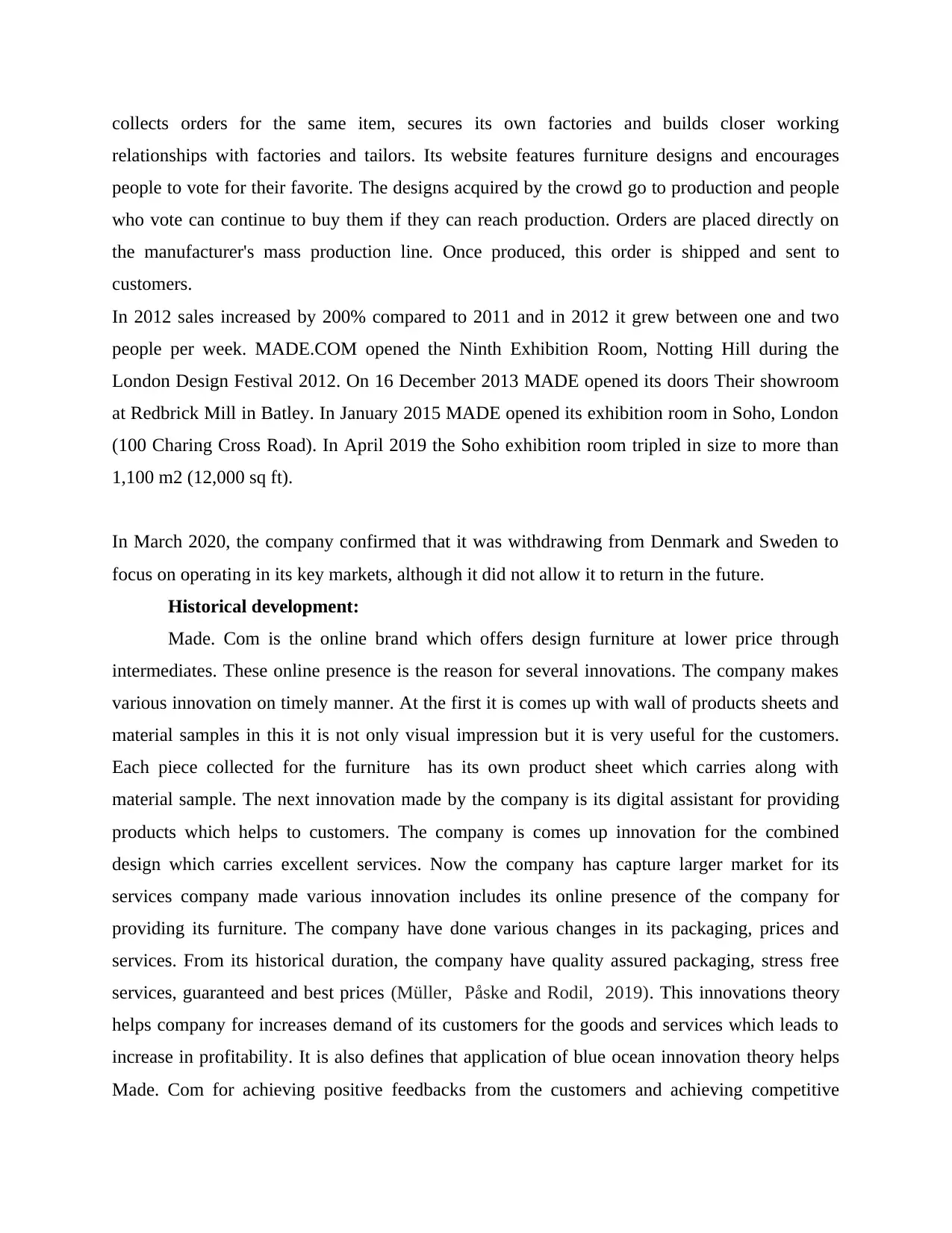
collects orders for the same item, secures its own factories and builds closer working
relationships with factories and tailors. Its website features furniture designs and encourages
people to vote for their favorite. The designs acquired by the crowd go to production and people
who vote can continue to buy them if they can reach production. Orders are placed directly on
the manufacturer's mass production line. Once produced, this order is shipped and sent to
customers.
In 2012 sales increased by 200% compared to 2011 and in 2012 it grew between one and two
people per week. MADE.COM opened the Ninth Exhibition Room, Notting Hill during the
London Design Festival 2012. On 16 December 2013 MADE opened its doors Their showroom
at Redbrick Mill in Batley. In January 2015 MADE opened its exhibition room in Soho, London
(100 Charing Cross Road). In April 2019 the Soho exhibition room tripled in size to more than
1,100 m2 (12,000 sq ft).
In March 2020, the company confirmed that it was withdrawing from Denmark and Sweden to
focus on operating in its key markets, although it did not allow it to return in the future.
Historical development:
Made. Com is the online brand which offers design furniture at lower price through
intermediates. These online presence is the reason for several innovations. The company makes
various innovation on timely manner. At the first it is comes up with wall of products sheets and
material samples in this it is not only visual impression but it is very useful for the customers.
Each piece collected for the furniture has its own product sheet which carries along with
material sample. The next innovation made by the company is its digital assistant for providing
products which helps to customers. The company is comes up innovation for the combined
design which carries excellent services. Now the company has capture larger market for its
services company made various innovation includes its online presence of the company for
providing its furniture. The company have done various changes in its packaging, prices and
services. From its historical duration, the company have quality assured packaging, stress free
services, guaranteed and best prices (Müller, Påske and Rodil, 2019). This innovations theory
helps company for increases demand of its customers for the goods and services which leads to
increase in profitability. It is also defines that application of blue ocean innovation theory helps
Made. Com for achieving positive feedbacks from the customers and achieving competitive
relationships with factories and tailors. Its website features furniture designs and encourages
people to vote for their favorite. The designs acquired by the crowd go to production and people
who vote can continue to buy them if they can reach production. Orders are placed directly on
the manufacturer's mass production line. Once produced, this order is shipped and sent to
customers.
In 2012 sales increased by 200% compared to 2011 and in 2012 it grew between one and two
people per week. MADE.COM opened the Ninth Exhibition Room, Notting Hill during the
London Design Festival 2012. On 16 December 2013 MADE opened its doors Their showroom
at Redbrick Mill in Batley. In January 2015 MADE opened its exhibition room in Soho, London
(100 Charing Cross Road). In April 2019 the Soho exhibition room tripled in size to more than
1,100 m2 (12,000 sq ft).
In March 2020, the company confirmed that it was withdrawing from Denmark and Sweden to
focus on operating in its key markets, although it did not allow it to return in the future.
Historical development:
Made. Com is the online brand which offers design furniture at lower price through
intermediates. These online presence is the reason for several innovations. The company makes
various innovation on timely manner. At the first it is comes up with wall of products sheets and
material samples in this it is not only visual impression but it is very useful for the customers.
Each piece collected for the furniture has its own product sheet which carries along with
material sample. The next innovation made by the company is its digital assistant for providing
products which helps to customers. The company is comes up innovation for the combined
design which carries excellent services. Now the company has capture larger market for its
services company made various innovation includes its online presence of the company for
providing its furniture. The company have done various changes in its packaging, prices and
services. From its historical duration, the company have quality assured packaging, stress free
services, guaranteed and best prices (Müller, Påske and Rodil, 2019). This innovations theory
helps company for increases demand of its customers for the goods and services which leads to
increase in profitability. It is also defines that application of blue ocean innovation theory helps
Made. Com for achieving positive feedbacks from the customers and achieving competitive
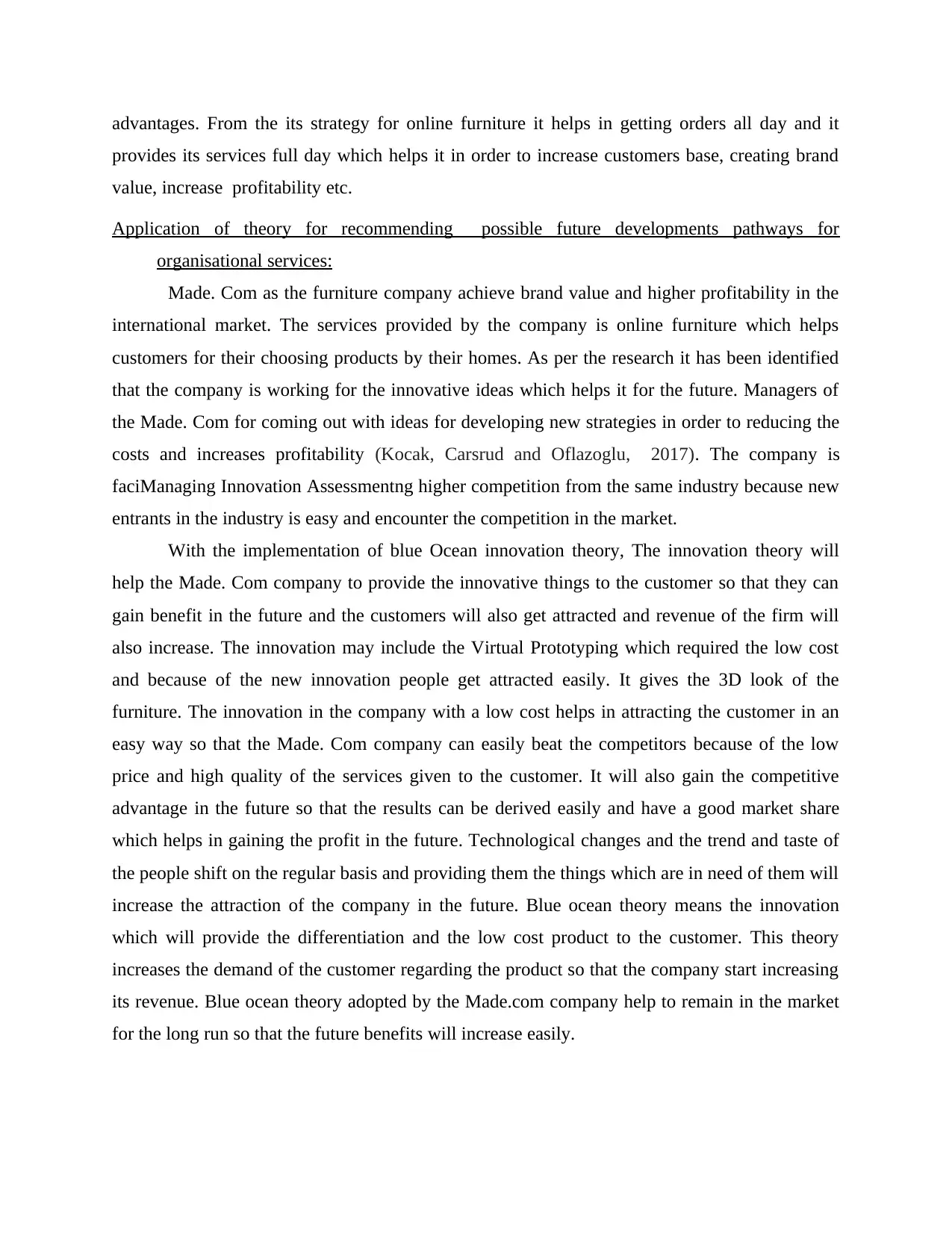
advantages. From the its strategy for online furniture it helps in getting orders all day and it
provides its services full day which helps it in order to increase customers base, creating brand
value, increase profitability etc.
Application of theory for recommending possible future developments pathways for
organisational services:
Made. Com as the furniture company achieve brand value and higher profitability in the
international market. The services provided by the company is online furniture which helps
customers for their choosing products by their homes. As per the research it has been identified
that the company is working for the innovative ideas which helps it for the future. Managers of
the Made. Com for coming out with ideas for developing new strategies in order to reducing the
costs and increases profitability (Kocak, Carsrud and Oflazoglu, 2017). The company is
faciManaging Innovation Assessmentng higher competition from the same industry because new
entrants in the industry is easy and encounter the competition in the market.
With the implementation of blue Ocean innovation theory, The innovation theory will
help the Made. Com company to provide the innovative things to the customer so that they can
gain benefit in the future and the customers will also get attracted and revenue of the firm will
also increase. The innovation may include the Virtual Prototyping which required the low cost
and because of the new innovation people get attracted easily. It gives the 3D look of the
furniture. The innovation in the company with a low cost helps in attracting the customer in an
easy way so that the Made. Com company can easily beat the competitors because of the low
price and high quality of the services given to the customer. It will also gain the competitive
advantage in the future so that the results can be derived easily and have a good market share
which helps in gaining the profit in the future. Technological changes and the trend and taste of
the people shift on the regular basis and providing them the things which are in need of them will
increase the attraction of the company in the future. Blue ocean theory means the innovation
which will provide the differentiation and the low cost product to the customer. This theory
increases the demand of the customer regarding the product so that the company start increasing
its revenue. Blue ocean theory adopted by the Made.com company help to remain in the market
for the long run so that the future benefits will increase easily.
provides its services full day which helps it in order to increase customers base, creating brand
value, increase profitability etc.
Application of theory for recommending possible future developments pathways for
organisational services:
Made. Com as the furniture company achieve brand value and higher profitability in the
international market. The services provided by the company is online furniture which helps
customers for their choosing products by their homes. As per the research it has been identified
that the company is working for the innovative ideas which helps it for the future. Managers of
the Made. Com for coming out with ideas for developing new strategies in order to reducing the
costs and increases profitability (Kocak, Carsrud and Oflazoglu, 2017). The company is
faciManaging Innovation Assessmentng higher competition from the same industry because new
entrants in the industry is easy and encounter the competition in the market.
With the implementation of blue Ocean innovation theory, The innovation theory will
help the Made. Com company to provide the innovative things to the customer so that they can
gain benefit in the future and the customers will also get attracted and revenue of the firm will
also increase. The innovation may include the Virtual Prototyping which required the low cost
and because of the new innovation people get attracted easily. It gives the 3D look of the
furniture. The innovation in the company with a low cost helps in attracting the customer in an
easy way so that the Made. Com company can easily beat the competitors because of the low
price and high quality of the services given to the customer. It will also gain the competitive
advantage in the future so that the results can be derived easily and have a good market share
which helps in gaining the profit in the future. Technological changes and the trend and taste of
the people shift on the regular basis and providing them the things which are in need of them will
increase the attraction of the company in the future. Blue ocean theory means the innovation
which will provide the differentiation and the low cost product to the customer. This theory
increases the demand of the customer regarding the product so that the company start increasing
its revenue. Blue ocean theory adopted by the Made.com company help to remain in the market
for the long run so that the future benefits will increase easily.
⊘ This is a preview!⊘
Do you want full access?
Subscribe today to unlock all pages.

Trusted by 1+ million students worldwide
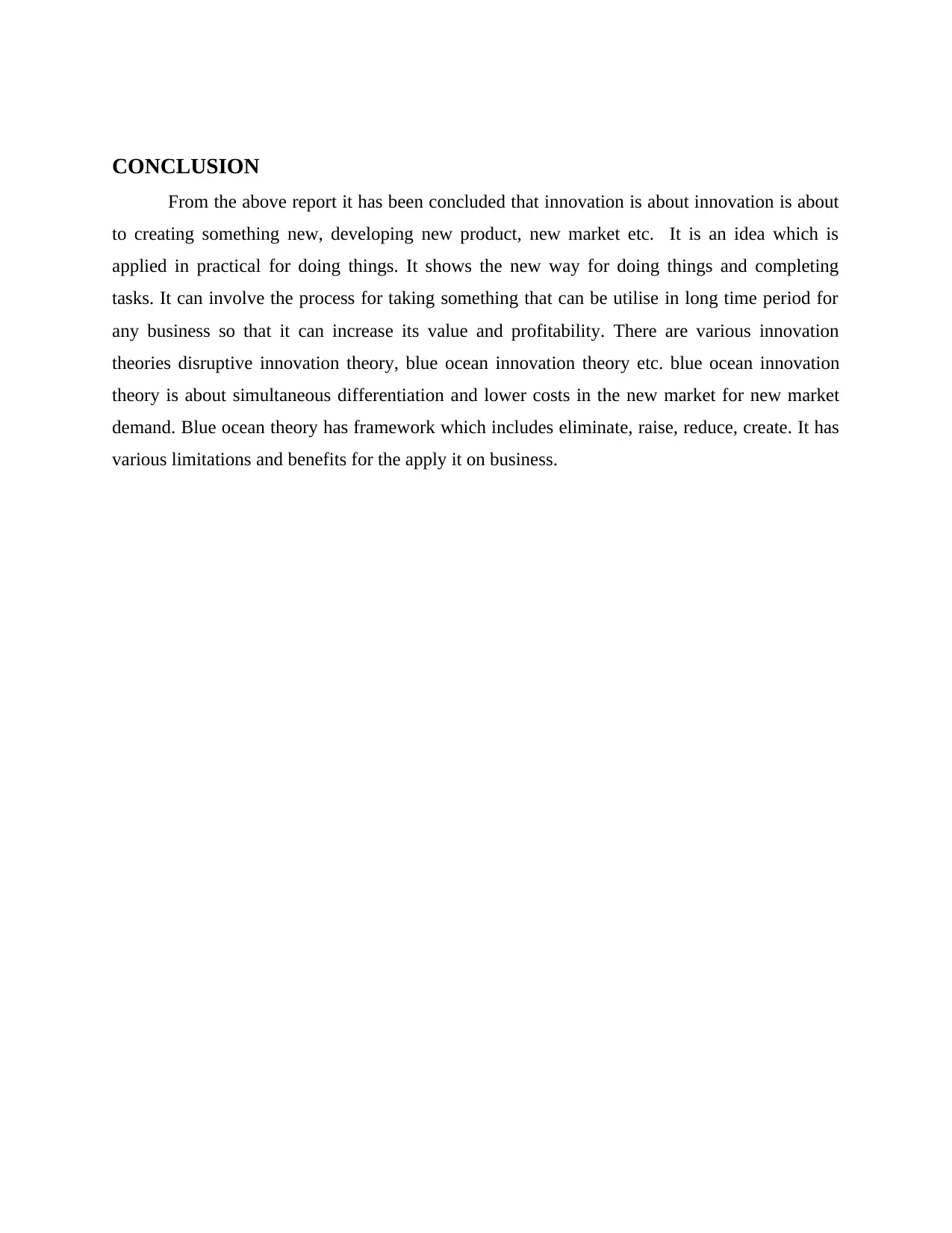
CONCLUSION
From the above report it has been concluded that innovation is about innovation is about
to creating something new, developing new product, new market etc. It is an idea which is
applied in practical for doing things. It shows the new way for doing things and completing
tasks. It can involve the process for taking something that can be utilise in long time period for
any business so that it can increase its value and profitability. There are various innovation
theories disruptive innovation theory, blue ocean innovation theory etc. blue ocean innovation
theory is about simultaneous differentiation and lower costs in the new market for new market
demand. Blue ocean theory has framework which includes eliminate, raise, reduce, create. It has
various limitations and benefits for the apply it on business.
From the above report it has been concluded that innovation is about innovation is about
to creating something new, developing new product, new market etc. It is an idea which is
applied in practical for doing things. It shows the new way for doing things and completing
tasks. It can involve the process for taking something that can be utilise in long time period for
any business so that it can increase its value and profitability. There are various innovation
theories disruptive innovation theory, blue ocean innovation theory etc. blue ocean innovation
theory is about simultaneous differentiation and lower costs in the new market for new market
demand. Blue ocean theory has framework which includes eliminate, raise, reduce, create. It has
various limitations and benefits for the apply it on business.
Paraphrase This Document
Need a fresh take? Get an instant paraphrase of this document with our AI Paraphraser
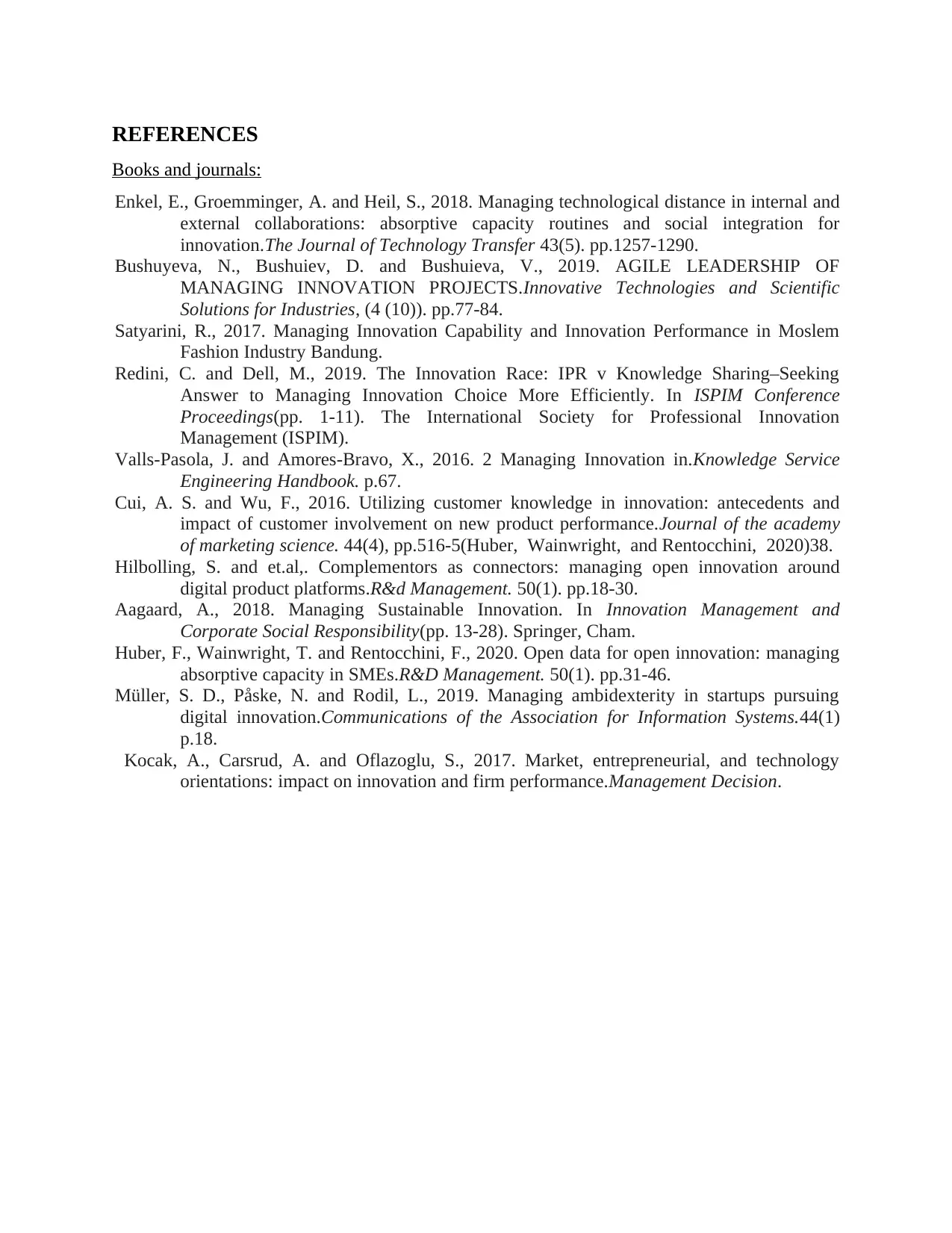
REFERENCES
Books and journals:
Enkel, E., Groemminger, A. and Heil, S., 2018. Managing technological distance in internal and
external collaborations: absorptive capacity routines and social integration for
innovation.The Journal of Technology Transfer 43(5). pp.1257-1290.
Bushuyeva, N., Bushuiev, D. and Bushuieva, V., 2019. AGILE LEADERSHIP OF
MANAGING INNOVATION PROJECTS.Innovative Technologies and Scientific
Solutions for Industries, (4 (10)). pp.77-84.
Satyarini, R., 2017. Managing Innovation Capability and Innovation Performance in Moslem
Fashion Industry Bandung.
Redini, C. and Dell, M., 2019. The Innovation Race: IPR v Knowledge Sharing–Seeking
Answer to Managing Innovation Choice More Efficiently. In ISPIM Conference
Proceedings(pp. 1-11). The International Society for Professional Innovation
Management (ISPIM).
Valls-Pasola, J. and Amores-Bravo, X., 2016. 2 Managing Innovation in.Knowledge Service
Engineering Handbook. p.67.
Cui, A. S. and Wu, F., 2016. Utilizing customer knowledge in innovation: antecedents and
impact of customer involvement on new product performance.Journal of the academy
of marketing science. 44(4), pp.516-5(Huber, Wainwright, and Rentocchini, 2020)38.
Hilbolling, S. and et.al,. Complementors as connectors: managing open innovation around
digital product platforms.R&d Management. 50(1). pp.18-30.
Aagaard, A., 2018. Managing Sustainable Innovation. In Innovation Management and
Corporate Social Responsibility(pp. 13-28). Springer, Cham.
Huber, F., Wainwright, T. and Rentocchini, F., 2020. Open data for open innovation: managing
absorptive capacity in SMEs.R&D Management. 50(1). pp.31-46.
Müller, S. D., Påske, N. and Rodil, L., 2019. Managing ambidexterity in startups pursuing
digital innovation.Communications of the Association for Information Systems.44(1)
p.18.
Kocak, A., Carsrud, A. and Oflazoglu, S., 2017. Market, entrepreneurial, and technology
orientations: impact on innovation and firm performance.Management Decision.
Books and journals:
Enkel, E., Groemminger, A. and Heil, S., 2018. Managing technological distance in internal and
external collaborations: absorptive capacity routines and social integration for
innovation.The Journal of Technology Transfer 43(5). pp.1257-1290.
Bushuyeva, N., Bushuiev, D. and Bushuieva, V., 2019. AGILE LEADERSHIP OF
MANAGING INNOVATION PROJECTS.Innovative Technologies and Scientific
Solutions for Industries, (4 (10)). pp.77-84.
Satyarini, R., 2017. Managing Innovation Capability and Innovation Performance in Moslem
Fashion Industry Bandung.
Redini, C. and Dell, M., 2019. The Innovation Race: IPR v Knowledge Sharing–Seeking
Answer to Managing Innovation Choice More Efficiently. In ISPIM Conference
Proceedings(pp. 1-11). The International Society for Professional Innovation
Management (ISPIM).
Valls-Pasola, J. and Amores-Bravo, X., 2016. 2 Managing Innovation in.Knowledge Service
Engineering Handbook. p.67.
Cui, A. S. and Wu, F., 2016. Utilizing customer knowledge in innovation: antecedents and
impact of customer involvement on new product performance.Journal of the academy
of marketing science. 44(4), pp.516-5(Huber, Wainwright, and Rentocchini, 2020)38.
Hilbolling, S. and et.al,. Complementors as connectors: managing open innovation around
digital product platforms.R&d Management. 50(1). pp.18-30.
Aagaard, A., 2018. Managing Sustainable Innovation. In Innovation Management and
Corporate Social Responsibility(pp. 13-28). Springer, Cham.
Huber, F., Wainwright, T. and Rentocchini, F., 2020. Open data for open innovation: managing
absorptive capacity in SMEs.R&D Management. 50(1). pp.31-46.
Müller, S. D., Påske, N. and Rodil, L., 2019. Managing ambidexterity in startups pursuing
digital innovation.Communications of the Association for Information Systems.44(1)
p.18.
Kocak, A., Carsrud, A. and Oflazoglu, S., 2017. Market, entrepreneurial, and technology
orientations: impact on innovation and firm performance.Management Decision.
1 out of 11
Related Documents
Your All-in-One AI-Powered Toolkit for Academic Success.
+13062052269
info@desklib.com
Available 24*7 on WhatsApp / Email
![[object Object]](/_next/static/media/star-bottom.7253800d.svg)
Unlock your academic potential
Copyright © 2020–2025 A2Z Services. All Rights Reserved. Developed and managed by ZUCOL.





